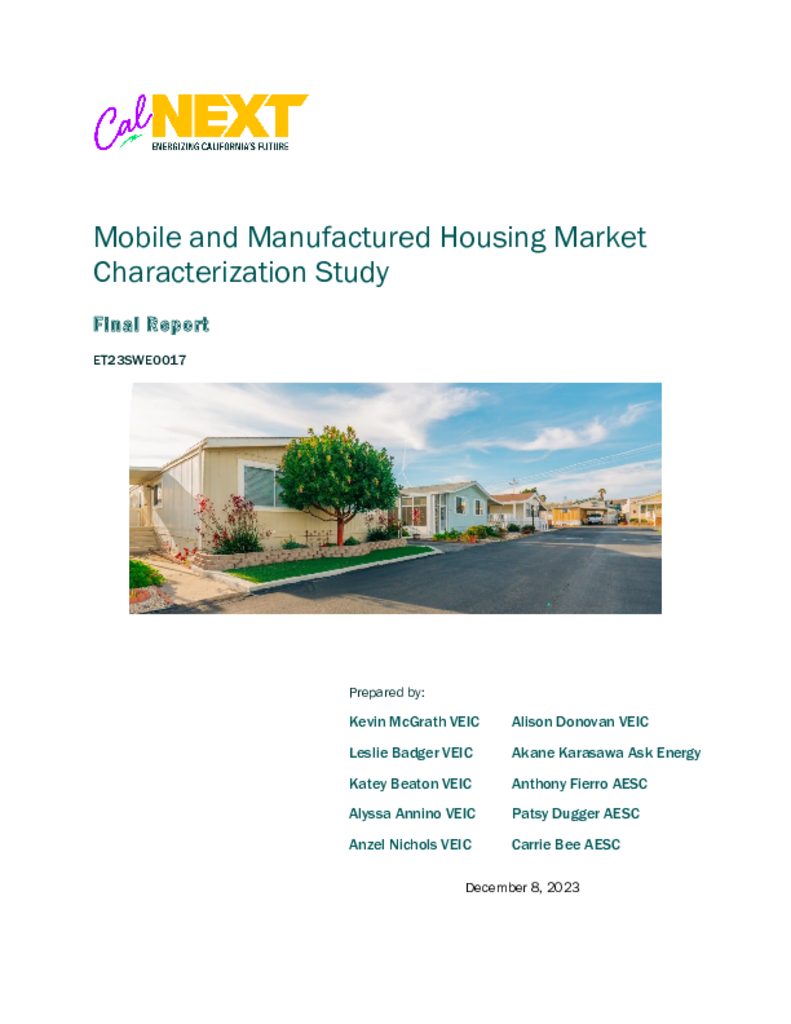ET23SWE0017 - Mobile and Manufactured Housing Market Characterization Study
VEIC proposes to compile and analyze data on the mobile and manufactured housing (MMH) sector to better understand technical and market barriers to electrification. The project team will gather geographical/climate zone data, ownership data, site/building characteristics including age, equipment and appliance baselines, fuel types, existing programs, existing permitting, codes & standards, manufacturer landscape, and contractor network. Additionally, based on findings from the research, VEIC will create energy models that characterize typical existing MMH across California climate zones and develop all electric retrofit measure packages. Where whole home replacement is recommended, VEIC will use the same energy model inputs characterizing new manufactured housing from TRC’s CalNEXT project called “Manufactured Housing Electrification Measure Development Support.” Energy models will be utilized to calculate energy, peak load, utility bill, and greenhouse gas reduction potential and inform electrification decisions that are beneficial to homeowners. Finally, this project will recommend strategies to reach MMH occupants which often reside in hard to reach (HTR) and disadvantaged communities (DAC), a list of technologies needed, a retrofit vs replace decision making tree, and summary of opportunities and barriers in the market to inform existing and future retrofit/replacement programs, in particular, the California Energy Commission Equitable Building Decarbonization Program, the utility comprehensive manufactured homes retrofit programs and the Statewide Residential New Construction Program. The project team will also provide policy and strategy recommendations for cases where energy and cost modeling indicate higher cost burdens due to electrification.
Manufactured housing is an important source of affordable housing. However, despite lower upfront purchase costs compared to site-built homes, residents of manufactured homes face greater energy insecurity, higher energy costs per square footage, and higher housing cost burdens than residents of other housing types (Kaul and Pang 2022, Bell-Pasht 2023). Codes that regulate the construction and efficiency of manufactured housing lag behind energy efficiency codes implemented for site-built construction, and while there is increasing demand for new, higher efficiency options in manufactured housing, existing homes often are inefficient.
As California pursues decarbonization and electrification goals, retrofitting manufactured housing with energy efficiency and electrification measures presents an opportunity for residents and utilities to save energy and reduce emissions, but gaps exist for understanding the market and technical potential. The purpose of this study is to gain a better understanding of the existing stock of manufactured homes in California, identify barriers and opportunities to electrification and energy efficiency retrofits, and identify where whole-home replacement may be a better option than an electrification retrofit. To address these gaps, this project assessed the characteristics of manufactured housing and residents in California; reviewed existing program offerings, permitting processes, codes and standards regulating existing and new manufactured homes; identified electrification retrofit measure packages; and assessed potential energy savings, bill impacts, peak demand, and greenhouse gas impacts of all-electric retrofit scenarios and high-performance new construction standards. This information was gathered and developed through secondary research, analysis of public datasets, stakeholder interviews, and energy modeling.

